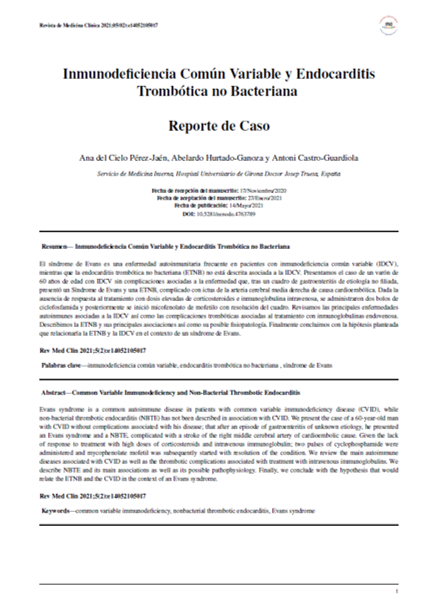Resumen
El síndrome de Evans es una enfermedad autoinmunitaria frecuente en pacientes con inmunodeficiencia común variable (IDCV), mientras que la endocarditis trombótica no bacteriana (ETNB) no está descrita asociada a la IDCV. Presentamos el caso de un varón de 60 años de edad con IDCV sin complicaciones asociadas a la enfermedad; que tras un cuadro de gastroenteritis de etiología no filiada, presentó un Síndrome de Evans y una ETNB, complicado con ictus de la arteria cerebral media derecha de causa cardioembólica. Dada la ausencia de respuesta al tratamiento con dosis elevadas de corticosteroides e inmunoglobulina intravenosa; se administraron dos bolus de ciclofosfamida y posteriormente se inició micofenolato de mofetilo con resolución del cuadro. Revisamos las principales enfermedades autoinmunes asociadas a la IDCV así como las complicaciones trombóticas asociadas a al tratamiento con inmunoglobulinas endovenosa. Describimos la ETNB y sus principales asociaciones así como su posible fisiopatología. Finalmente concluimos con la hipótesis planteada que relacionaría la ETNB y la IDCV en el contexto de un síndrome de Evans.
Referencias
Bonilla, F. A., Barlan, I., Chapel, H. (2016). International Consensus Document (ICON): Common Variable Immunodeficiency Disorders. Journal of Allergy and Clinical Immunology: In Practice, 4(1), 38–59. DOI: 10.1016/j.jaip.2015.07.025
Kitcharoensakkul, M., Cooper, M. A. (2020). Autoimmunity in Primary Immunodeficiency Disorders. In The Autoimmune Diseases (pp. 513–532). DOI:10.1016/B978-0-12-812102- 3.00028-23INMUNODEFICIENCIA COMÚN Y ENDOCARDITIS PÉREZ-JAÉN, A et al.
Gathmann, B., Mahlaoui, N. (2014). Clinical picture and treatment of 2212 patients with common variable immunodeficiency. Journal of Allergy and Clinical Immunology, 134(1). DOI: 10.1016/j.jaci.2013.12.1077
Wang, J., Cunningham-Rundles, C. (2005). Treatment and outcome of autoimmune hematologic disease in common variable immunodeficiency (CVID). Journal of Autoimmunity, 25(1), 57–62. DOI: 10.1016/j.jaut.2005.04.006
Feuille, E. J., Anooshiravani, N. (2018). Autoimmune Cytopenias and Associated Conditions in CVID: a Report From the USIDNET Registry. Journal of Clinical Immunology, 38(1), 28–34. DOI: 10.1007/s10875-017-0456-9
Chapel, H., Lucas, M. (2012). Confirmation and improvement of criteria for clinical phenotyping in common variable immunodeficiency disorders in replicate cohorts. Journal of Allergy and Clinical Immunology, 130(5), 1197-1198.e9.
DOI:10.1016/j.jaci.2012.05.046
Azizi, G., Abolhassani, H.. (2017). Autoimmunity in common variable immunodeficiency: epidemiology, pathophysiology and management. Expert Review of Clinical Immunology, 13(2), 101–115. DOI: 10.1080/1744666X.2016.1224664
Abbott JK, Gelfand EW. (2015). Common Variable Immunodeficiency: Diagnosis, Management, and Treatment. Immunol Allergy Clin North Am. Nov;35(4):637-58. DOI:10.1016/j.iac.2015.07.009
Cherin P, Marie I, Michallet M,et al. (2016) Management of adverse events in the treatment of patients with immunoglobulin therapy: A review of evidence. Autoimmun Rev. Jan;15(1):71-81. DOI:10.1016/j.autrev.2015.09.002
Ramírez E, Romero-Garrido JA, López-Granados E, et al. (2014) Symptomatic thromboembolic events in patients treated with intravenous-immunoglobulins: results from a retrospective cohort study. Thromb Res. Jun;133(6):1045-51. DOI:10.1016/j.thromres.2014.03.046
Marie I, Maurey G, Hervé F, et al. (2006). Intravenous immunoglobulin-associated arterial and venous thrombosis; report of a series and review of the literature. Br J Dermatol. Oct;155(4):714-21. DOI:10.1111/j.1365-2133.2006.07390.x
Azizi G, Abolhassani H, Asgardoon MH, Shaghaghi S, et al. (2016) Managing patients with side effects and adverse events to immunoglobulin therapy. Expert Rev Clin Pharmacol. 9(1):91-102. DOI:10.1586/17512433.2016.1105131
Liu, J., Frishman, W. H. (2016). Nonbacterial Thrombotic Endocarditis: Pathogenesis, Diagnosis, and Management. Cardiology in Review, 24(5), 244–247. DOI: 10.1097/CRD.0000000000000106
Lee, J. L., Naguwa, S. M. (2009). Revisiting Libman-Sacks endocarditis: A historical review and update. Clinical Reviews in Allergy and Immunology, 36(2–3), 126–130. DOI: 10.1007/s12016-008-8113-y
Byrnes, J. R., Wolberg, A. S. (2017). Red blood cells in thrombosis. Blood, 130(16), 1795–1799. DOI: 10.1182/blood2017-03-745349
Lecouffe-Desprets, M., Néel, A. (2015). Venous thromboembolism related to warm autoimmune hemolytic anemia: A case control study. Autoimmunity Reviews, 14(11),1023–1028. DOI: 10.1016/j.autrev.2015.07.001
Audia, S., Bach, B., Samson, M., Lakomy, D., Bour, J. B., Burlet, B., . . . Bonnotte, B. (2018). Venous thromboembolic events during warm autoimmune hemolytic anemia. PLoS ONE, 13(11), 1–13. DOI:10.1371/journal.pone.0207218
Barcellini W, et al. (2014) Clinical heterogeneity and predictors of outcome in primary autoimmune hemolytic anemia: a GIMEMA study of 308 patients. Blood,124(19):2930–6. DOI: 10.1182/blood-2014-06-583021
L’Acqua, C., Hod, E. (2015). New perspectives on the thrombotic complications of haemolysis. British Journal of Haematology, 168(2), 175–185. DOI:10.1111/bjh.13183
Ataga, K. I. (2009). Hypercoagulability and thrombotic complications in hemolytic anemias. Haematologica, 94(11), 1481–1484. DOI:10.3324/haematol.2009.013672
Bordin G, Boldorini R, (2003). The two hit hypothesis in the antiphospholipid syndrome: Acute ischaemic heart involvement after valvular replacement despite anticoagulation in a patient with secondary APS. Lupus.12:851–3. DOI:10.1191/0961203303lu445cr

Esta obra está bajo una licencia internacional Creative Commons Atribución-NoComercial-SinDerivadas 4.0.
Derechos de autor 2021 Ana del Cielo Pérez-Jaén, Abelardo Hurtado-Ganoza, Antoni Castro-Guardiola

